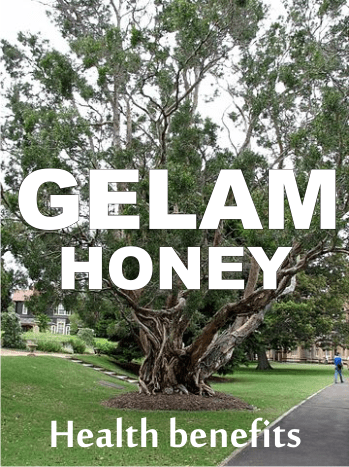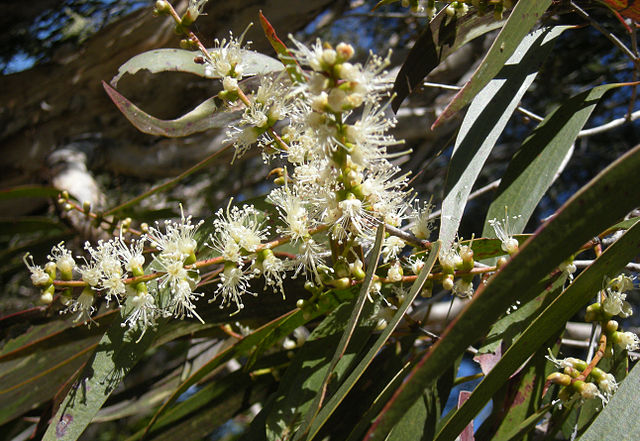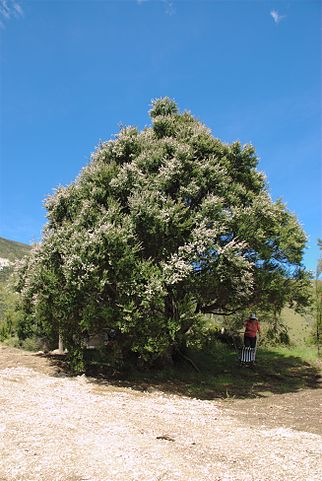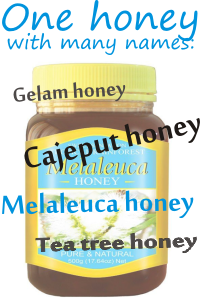What is melaleuca honey? And who heard of this, anyway? And why so many studies about a honey that cannot be found on the market? Could it be from the actual Tea tree?
The truth is that all countries have specific trees and that some names are borrowed as they are, others are translated, others are scientific, and others are kept from tradition. This is what happens to this tree and to so many others on this planet. But it’s important to known which are which.
Gelam honey or Melaleuca honey is Malaysian honey produced from some species of trees in Melaleuca genus, Family Myrtaceae. Especially from the tree called Melaleuca cajuputi, also known as Melaleuca leucadendra or leucodendron.
The names of this tree can confuse a lot of people, especially as they are all related to “tea tree”.
In English: tea tree, paperbark tree, cajeput tree, punk tree, river tea tree, weeping tea tree, white wood, broad-leaved paperbark.
In China: bai qian ceng
In Indonesia: cajeput, gelam, minjak kajuputih,
In Malaysia: gelam, kayu puteh
I was so surprised to see how many different, unrelated plants are called “Tea Tree” or “Ti-Tree”. What is the real one? If there is such a thing like the real one….
There are 6 plants that are called Tea Tree!

1. Camellia sinensis (or Thea sinensis) Other names: “tea plant”, “tea shrub”, and “tea tree”. (Again “tea tree” – though it is not the tea tree used to make the honey, or the “tea tree oil”)
It’s a species of evergreen shrub or small tree, whose leaves and leaf buds are used to produce tea. Our teas comes from here.
This plant has 2 major varieties: sinensis for Chinese teas, and assamica for Indian Assam teas.
From the leaves of those two plants we have the following teas:
White tea, yellow tea, green tea, oolong, pu-erh tea and black tea. What differentiate them is the the way they are processed to attain varying levels of oxidation.
From the twigs and stems of Camellia sinensis we have Kukicha, aka twig tea.
White tea, yellow tea, green tea, oolong tea,
pu-erh tea, black tea and twig tea come from this plant.
2. Melaleuca species from Myrtaceae family. The best-accepted common name for Melaleuca is simply melaleuca; however most of the larger species are also known as tea tree, and the smaller types as honey myrtles, while those species in which the bark is shed in flat, flexible sheets are referred to as paperbarks.
 There are more than 200 species, most of them from Australia, a few from Malesia and 7 species from New Caledonia. Their flowers are crowded together in a spike of variable length, usually red or pink with numerous stamens, the fruits are woody capsules crowded together.
There are more than 200 species, most of them from Australia, a few from Malesia and 7 species from New Caledonia. Their flowers are crowded together in a spike of variable length, usually red or pink with numerous stamens, the fruits are woody capsules crowded together.
The leaves are usually narrow and when they are held to the light we can see oil dots on them. When the leaves are crushed this oil produces a characteristic smell.
The tree is probably called “Tea tree” because the water courses near by turn to brown after the leaves fall down, into them. Otherwise, its leaves are not used for tea, but for their oil.
• Melaleuca alternifolia is notable for its essential oil, which is anti-fungal and antibiotic, and safely usable for topical applications. It is produced on a commercial scale and labeled as Tea Tree Oil.
The Tea Tree OIL comes from Melaleuca alternifolia.
(which is not the Tea Tree known by North Americans)

• Melaleuca leucadendra, also known as Melaleuca leucadendron, cajeput tree or white tree (derived from the old Indonesian spelling: kaju putih – meaning “white wood”). It is native to Australia and is commonly known in North America as the Tea Tree. (!) The Malay name of this tree is “gelam”. The honey made from its nectar is called “gelam honey”.
Cajeput tree is the name given to all these melaleuca species:
M. leucadendra, M. linariifolia, M. viridiflora and M. quinquenervia.
The cajeput trees are also important for their oils, especially in Southeast Asia, where the essential oil is extracted from the leaves and twigs of the tree.
Organic Cajeput Essential Oil (15 ml) – 100% Pure Undiluted Therapeutic Grade Essential Oil by Prana Organic Plant Oils is made from M. leucadendra and M. quinquenervia species and is primarily used in aromatherapy as an expectorant, painkiller, antifungal oil and skin mite reducer. The cajeput oli is used for: toothache, colds, headaches, tumors, used as a tonic, thinning mucous (congestion) and making it easier to cough up, when taken by mouth or inhaled. Also good for fungal skin infections, when applied to the skin. Helps in joint pain (rheumatism), when applied to the skin.
The oil is also used in many pet fish remedies, promoting fin and tissue regrowth, such as Bettafix (which contains a lighter dilution of cajeput tree oil) and Melafix (in a stronger dilution), to treat bacterial and fungal infections.
North Americans call the Cajeput tree, Tea tree.
Cajeput trees grown in Australia are well known for having powerful therapeutic properties. Compared to other countries, Australia’s Cajeput contains high amounts of anti-infectious properties (cineol, pinene and others), and is a favorite among health professionals.
Gelam honey is made of Cajeput tree (especially Melaleuca leucadendra)
All melaleuca species are very rich in nectar and pollen. Birds and other animals are very attracted to the them. Honey bees produce what we call “gelam honey”, with powerful health benefits. It is one of the most common types of honey found in lowland rain forest of Peninsular Malaysia. And because the tree is called “gelam” in Malayan, and most of the studies were made at the University of Malaya, the name “gelam honey” was preferred.
3. Leptospermum species, also in the family Myrtaceae, are also called Tea tree. This is because the early Australian settlers soaked the leaves of several species in boiling water to make a herbal tea rich in ascorbic acid (Vitamin C). It is said that Captain Cook brewed tea of Leptospermum leaves to prevent scurvy among his crews.
Mānuka honey is produced from mānuka bush (Leptospermum scoparium), and (again) tea tree (Leptospermum polygalifolium). Sometimes it is met as Leptospermum honey.
The honey produced from Australian Leptospermum polygalifolium, also known as jelly bush or the lemon-scented tea tree, has been found to contain up to 1750 mg/kg of ‘methylglyoxal’ (MGO), a powerful antibacterial compound.

4. Kunzea ericoides it is also known as Kānuka, White tea-tree or Burgan is a tree or shrub of Australia and New Zealand.
It was classified as being in the genus Leptospermum until 1983. but then considered to belong to Kunzea.
Mānuka and kānuka are superficially similar species and are often confused with one another. The easiest way to tell the difference between these trees is to feel the foliage, kānuka leaves are soft, while mānuka leaves are prickly. Kanuka oil is also a good therapeutic oil.
Mānuka honey and kānuka honey are not the same.
5. Lycium species, including
– Lycium europaeum or European tea tree, a deciduous shrub growing to 4 m. The fruit is a very rich source of vitamins and minerals, especially in vitamins A, C and E, flavanoids and other bio-active compounds. It is also a fairly good source of essential fatty acids, which is fairly unusual for a fruit. It is being investigated as a food that is capable of reducing the incidence of cancer and also as a means of halting or reversing the growth of cancers.
– Lycium barbarum or Duke of Argyll’s Tea Tree. It is one of two species of boxthorn in the family Solanaceae from which the goji berry or wolfberry is harvested, the other being Lycium chinense. A deciduous shrub growing up to 4 m, from which only the fully ripe fruits (aka goji berries) should be eaten. A very rich source of vitamins and minerals, especially in vitamins A, C and E, flavanoids, essential fatty acids and other bio-active compounds.
6. Ti Plant. Cordyline fruticosa, an evergreen flowering plant in the Asparagus family.
Alos known as: Cabbage Palm, Good Luck Plant, Palm Lily, Ti Plant, Kī, Lā‘ī (Hawaiian), Tī Pore (Māori), Sī (Tongan), Lauti (Samoan), andʻAutī (Tahitian).

This plant is native to tropical southeastern Asia, Papua New Guinea, Melanesia, northeastern Australia, the Indian Ocean, and parts of Polynesia. It is not native to either Hawaii or New Zealand but was introduced to both by Polynesian settlers. Its starchy rhizomes, which are very sweet when the plant is mature, were eaten as food or as medicine, and its leaves were used to thatch the roofs of houses, and to wrap and store food.
The Hawaiian hula skirt is a dense skirt with an opaque layer of at least 50 green leaves and the bottom (top of the leaves) shaved flat. In ancient Hawaiʻi the plant was thought to have great spiritual power; only kahuna (high priests) and aliʻi (chiefs) were able to wear leaves around their necks during certain ritual activities.
Tī leaves were also planted at the corners of the home to keep ghosts from entering the home or property (for which its alternative name: terminalis). To this day some Hawaiians plant tī near their houses to bring good luck.
How is gelam honey?
Gelam honey is produced from Melaleuca species, especially from Melaleuca leucadendra, aka Melaleuca leucadendron, Cajeput tree, Tea tree or White tree. Not from the Tea Tree the essential oils are made, not from the tea trees our green or black teas are made, or from the tea tree the manuka honey is made.
It is one of the main monofloral Malaysian honeys, among acacia, pineapple, nenas, longan, rubber tree, sourwood. Their polyfloral honey include: kelulut and tualang honey.
These days, gelam honey has become very popular and raise the science attention due to its high total phenolic content and high concentration of flavonoids.
Phenolic compounds that have been found in Gelam honey: ascorbic acid, catecilin, benzoic acid, naringenin, luteolin, kaempferol, apigenin, gallic acid, caffeic acid, ferulic acid, p-coumaric, quercetin and chlorogenic acid.
The researchers reported that the extracted phenolic and flavanoid content from Gelam honey showed in-vitro anti-inflammatory effect and they stated that gelam honey has a potential therapeutic value in an inflammatory conditions.
In addition, other research has found that gelam honey has been found to kill liver cancer cells, exhibiting selective cytotoxicity, anti-angiogenic, cytotoxic, and anti-proliferative properties, in both cell and animal research. Both, gelam and nenas monofloral honeys exhibit anti-cancer properites in colorectal cell lines.
**************
**************
References:
“Cordyline fruticosa plant with fruit” by Ethel Aardvark – Own work. Licensed under CC BY 3.0 via Wikimedia Commons
“Csinensis” by AxelBoldt at en.wikipedia – Transferred from en.wikipedia. Licensed under Public Domain via Wikimedia Commons
“Kanuka Tree in Puhi Puhi valley, near Kaikoura” by Karora – Own work. Licensed under Public Domain via Wikimedia Commons;
“Melaleuca leucadendron flowers” by Ethel Aardvark – Own work. Licensed under CC BY 3.0 via Wikimedia Commons
“Hula dancing girl” credit jasohill licensed under CC via flickr.com
http://www.wildsingapore.com/wildfacts/plants/coastal/melaleuca/cajuputi.htm
http://www-public.jcu.edu.au/discovernature/sci_p1/JCUDEV_005987
http://en.wikipedia.org/wiki/Melaleuca
Gelam Honey Scavenges Peroxynitrite During the Immune Response




